Nestled amidst the crystal-clear waters of the Gulf of Mexico, Dry Tortugas National Park stands as a testament to nature’s splendor and human endurance.
Beyond its famous Fort Jefferson lies a world of unparalleled marine biodiversity, tales of shipwrecks, and sunsets that paint the horizon.
A true hidden gem, this guide takes you on a deep dive into the park’s offerings, ensuring an unforgettable experience. Welcome to the wonder that is Dry Tortugas!

The Rich Tapestry of Dry Tortugas National Park
Tucked away in the Gulf of Mexico, the Dry Tortugas National Park doesn’t just offer breathtaking natural beauty but also a historical tapestry that dates back centuries.
Its rich past weaves tales of exploration, conflict, and innovation.
The Age of Exploration
The saga of Dry Tortugas begins in 1513 with the Spanish explorer Juan Ponce de León.
While he was primarily known for his quest for the Fountain of Youth, de León was the first European to note the Dry Tortugas, naming them “Las Tortugas” (The Turtles) due to the abundant sea turtles in the area.
The “Dry” prefix was later added to nautical maps to indicate the islands’ lack of freshwater springs.

Fort Jefferson: A Bastion in the Sea
The heart and soul of Dry Tortugas National Park is the massive coastal fortress known as Fort Jefferson.
Construction began in 1846, marking it as one of America’s most ambitious building projects of its time. Though it was never fully completed nor fully armed, Fort Jefferson played crucial roles throughout history.
The Civil War Era
During the Civil War, despite Florida seceding from the Union, Fort Jefferson remained under Union control.
It served as a strategic outpost, ensuring that the Gulf of Mexico remained navigable for Union vessels. It also functioned as a prison, housing deserters and those accused of treason.

The Infamous Dr. Mudd
One of Fort Jefferson’s most notable prisoners was Dr. Samuel Mudd, imprisoned for his role in the assassination of President Abraham Lincoln.
While he was involved in setting John Wilkes Booth’s broken leg, debates continue about the depth of his complicity.
However, during a yellow fever outbreak at the fort, Dr. Mudd’s medical expertise proved invaluable, and he earned respect for his efforts in treating afflicted soldiers and inmates.
A Refuge for Wildlife
Over time, the military significance of Fort Jefferson waned, but the ecological importance of the Dry Tortugas began to shine.
In 1935, it was proclaimed as a national monument to protect its unique environment and historical artifacts.
In 1992, the area was redesignated as Dry Tortugas National Park, emphasizing the importance of its ecological and historical assets.

Modern-Day Significance
Today, while the park is a haven for tourists seeking an escape, it’s also a focal point for marine biologists, historians, and birdwatchers.
The coral reefs teem with life, shipwrecks whisper tales from centuries past, and the skies see migratory birds making pitstops during their lengthy journeys.
In a world constantly evolving and modernizing, Dry Tortugas National Park stands as a testament to the tales of yesteryears and the natural beauty that has remained unchanged for millennia.
It reminds visitors that even in the most unexpected places, history is alive, and stories wait to be told.

Getting There
Navigating your way to Dry Tortugas National Park might feel like embarking on an expedition to a secluded paradise – because, in many ways, it is.
While slightly off the beaten path, the journey to this treasured national park can be part of the adventure itself. Here’s your essential guide to ensuring a smooth trip.
Transportation Options
Seaplane
One of the most scenic and exhilarating ways to reach Dry Tortugas National Park is via seaplane. As you soar above the Gulf of Mexico, you’re gifted with bird’s-eye views of the shimmering waters and the archipelago below.
Several operators offer direct flights from Key West, with the journey taking roughly 40 minutes. Remember to book in advance, especially during peak season, as these flights fill up quickly.

Ferry
For those who prefer sailing the seas, the ferry is a reliable and enjoyable option. The boat ride from Key West takes about 2 to 2.5 hours. While it’s a longer journey than the seaplane, the ferry offers a different kind of charm.
You can witness the changing hues of the water, spot marine life, and relax on the deck as you approach the national park. Ferries generally include some amenities like restrooms and a small snack bar.
Cost Considerations and Budgeting Tips
Dry Tortugas National Park can be a bit pricier to access compared to other national parks due to its remote location. Here are some tips to budget wisely:
- Early Bird Specials: Booking your transportation in advance can sometimes fetch you early bird discounts. Monitor the websites of ferry and seaplane operators for such deals.
- Park Entrance Fees: Remember, there’s an entrance fee for the park itself, so factor this into your budget. If you’re a frequent national park visitor, consider investing in an annual pass which covers entry to all national parks.
- Pack Essentials: Given the park’s remote nature, amenities can be limited. Packing essentials like water, snacks, or even a picnic can save you from buying pricier items on-site.
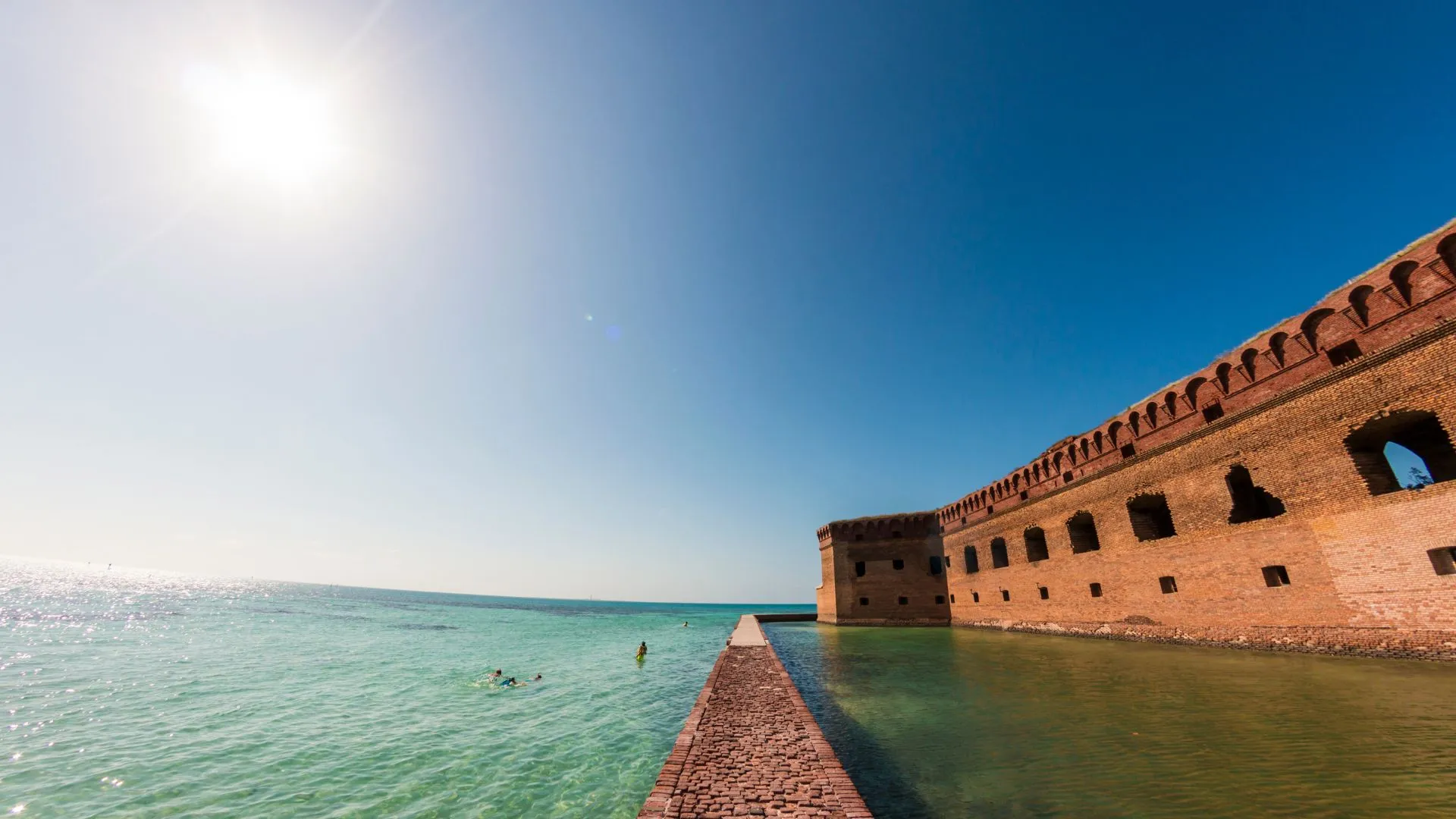
Best Times and Seasons to Visit
Dry Tortugas National Park is beautiful year-round, but there are some seasonal considerations:
- Peak Season (December to April): The weather is pleasant, making it a popular time for visitors. Expect more crowds and book accommodations and transport well in advance.
- Off-Peak (May to November): This period sees fewer tourists, but be wary of the hurricane season which typically runs from June to November. Always check weather advisories when planning.
As you plan your visit to Dry Tortugas National Park, remember that the journey is not just about reaching the destination, but the experiences you gather along the way.
With turquoise waters beckoning and history waiting to be discovered, your adventure is just beginning.

Key Attractions
Dry Tortugas National Park is more than just an isolated speck on the map. It’s an intertwining narrative of human endeavors and the sublime artistry of nature.
From colossal fortresses to serene underwater realms, here are the must-see attractions within the park:
Fort Jefferson
This massive, hexagonal fortress is undeniably the crown jewel of Dry Tortugas National Park.
Historical Significance and Stories
Built with over 16 million bricks, Fort Jefferson is the largest masonry structure in the Americas.
Initially conceived as a means to control navigation in the Gulf of Mexico and protect the Mississippi River trade, its importance grew during the Civil War.
While never seeing battle, its very presence was a deterrent, showcasing the might of the U.S. military.
Architectural Highlights and Features
The fort’s design is a marvel. It boasts a moat, drawbridge, and impressive bastions. The walls, which rise majestically from the sea, have withstood hurricanes and the test of time.
As you wander its ramparts, lookout points offer panoramic views of the surrounding waters, while archways and inner chambers echo stories from ages past.
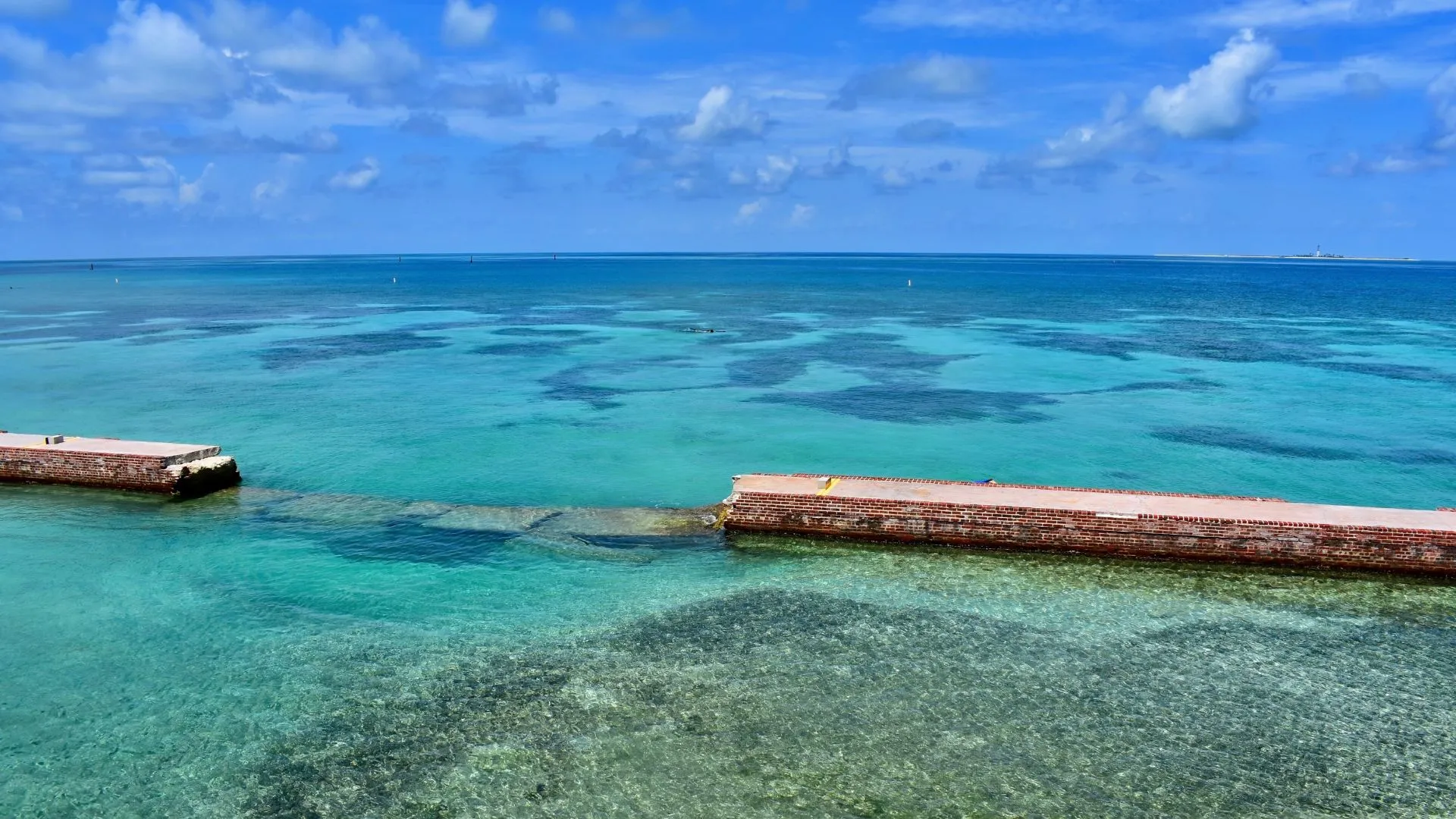
Loggerhead Key Lighthouse
Standing sentinel on Loggerhead Key, the westernmost isle, this lighthouse has been a beacon for sailors for over 150 years.
Importance and History
Before the lighthouse’s construction, the reefs around Dry Tortugas claimed numerous ships.
Recognizing the peril, the U.S. government commissioned the lighthouse in 1858. Over the years, it has undergone renovations but continues to serve its guiding purpose.
Viewing Tips and Best Times
While Loggerhead Key is off-limits for casual visits, boat tours often circle the island, providing excellent photo opportunities.
Dawn and dusk are magical times, with the lighthouse silhouetted against nature’s vibrant canvas.

Coral Reefs & Marine Life
Dry Tortugas National Park protects a vibrant and delicate underwater ecosystem, making it a favorite among marine enthusiasts.
Snorkeling and Diving Spots
The park boasts some of the healthiest coral reefs in the Florida Keys. Popular spots include the Windjammer Wreck, a shipwreck that’s now a thriving marine habitat, and the coral heads near Garden Key.
Both locations offer an array of colorful corals, fish, and occasionally, sightings of rays and small sharks.
Marine Species to Look Out For
Keep an eye out for the parrotfish, angelfish, and the graceful sea turtles that gave the Dry Tortugas their name. If you’re lucky, you might even spot a nurse shark or a barracuda gliding by.
These attractions are but a glimpse of what Dry Tortugas National Park has to offer. Every corner, every grain of sand, and every ripple in the water has a tale to tell.
Whether you’re a history buff, an adventure seeker, or someone seeking solace, this park beckons with open arms, promising experiences that linger long after the journey’s end.

Activities
Immerse yourself in the myriad of experiences that Dry Tortugas National Park offers.
Whether you’re an adventure enthusiast, a nature lover, or a history aficionado, there’s an activity tailored for you. Here’s a guide to the park’s most engaging pursuits:
Snorkeling & Diving
The crystalline waters of the park are a gateway to a mesmerizing underwater world.
Best Locations
- Garden Key: Ideal for beginners, the calm waters around Garden Key offer a shallow snorkeling experience where you can encounter diverse marine life.
- Windjammer Wreck: Dive into history! This shipwreck from the late 1800s is now a habitat for corals, sponges, and numerous fish species.
- Little Africa Reef: Named for its Africa-like shape, it’s a paradise for divers, boasting vibrant corals and a bustling marine community.
Equipment Rental and Tour Options
While there aren’t any rental facilities directly on the islands, many visitors rent gear in Key West or bring their own.
However, some ferry services offer complimentary snorkeling equipment as part of their package.
Safety Considerations
- Always snorkel or dive with a buddy.
- Check weather and sea conditions before venturing out.
- Maintain a safe distance from marine life, especially from delicate coral structures.
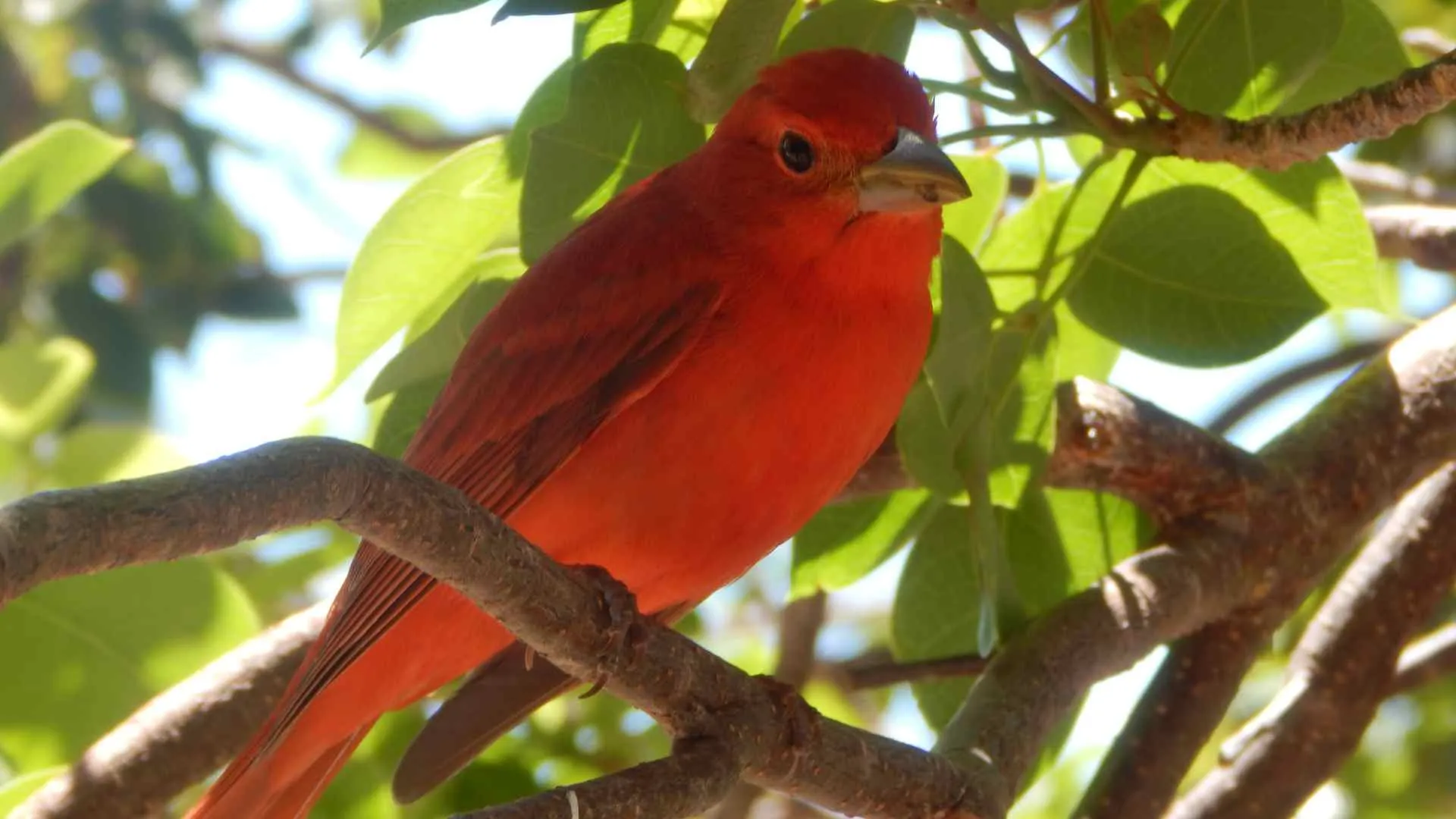
Bird Watching
The islands are a haven for avian enthusiasts, especially during migratory seasons.
Best Times and Locations
- Spring (April to June): Witness thousands of birds, including sooty terns and brown noddies, as they nest and rear their young.
- Bush Key: Closed during nesting but offers fantastic viewing from neighboring Garden Key.
- Loggerhead Key: Spot frigate birds soaring majestically above.
Notable Species and Their Habits
Watch out for the magnificent frigatebird with its red throat pouch, the agile peregrine falcon, and the comical-looking masked booby.
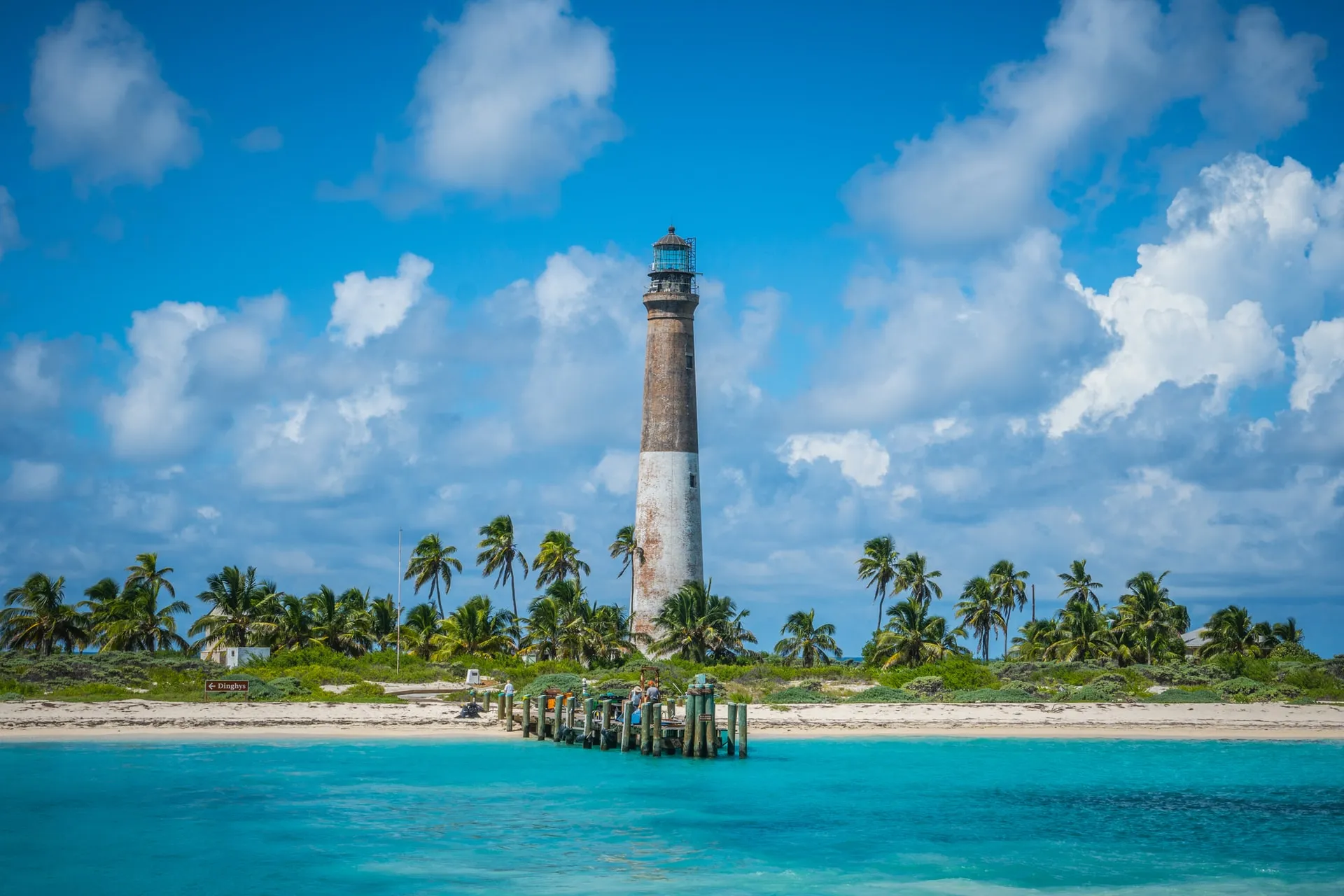
Camping
For those seeking a genuine wilderness experience, camping at Dry Tortugas National Park is an unforgettable adventure.
Available Facilities
The campground on Garden Key is primitive, with ground sites available on a first-come, first-served basis. There are no fresh water, food storage, or trash collection facilities, so come prepared.
Tips and Best Practices
- Store food securely to avoid attracting wildlife.
- Bring ample fresh water, as there’s none available on the islands.
- Always follow Leave No Trace principles.
Reservation Process
While daytime visits to the park don’t require reservations, camping does. Make sure to reserve your spot well in advance, especially during peak seasons.
Exploring Dry Tortugas National Park is akin to stepping into a world where time stands still, and nature reigns supreme.
Whether you’re floating above vibrant reefs, observing the elegant dance of seabirds, or sleeping under a canopy of stars, the park offers a resplendent array of activities that resonate with the soul. Embrace the adventure and let the islands narrate their age-old tales.

Ecosystem & Wildlife
Beyond its historical significance, Dry Tortugas National Park stands as a beacon of ecological importance.
Nestled at the crossroads of the Gulf of Mexico and the Atlantic Ocean, the park boasts a delicate balance of land and marine ecosystems, creating a refuge for a diverse range of flora and fauna.
Flora: Notable Plant Species and Their Significance
While the islands might seem barren at first glance, they host a unique collection of plant species adapted to the salt-laden winds and minimal freshwater.
Buttonwood Trees
These hardy trees are a testament to endurance. Tolerant to both drought and salt, they form dense thickets that provide shelter to various bird species.
Sea Grapes
Easily recognizable with their broad, round leaves and grape-like fruit clusters, sea grapes are crucial dune stabilizers, preventing soil erosion with their sprawling roots.
Seagrasses
Submerged meadows of seagrasses, especially turtle grass, flourish in the shallow waters around the islands. They play a pivotal role in the marine ecosystem, offering shelter and feeding grounds for various marine creatures.
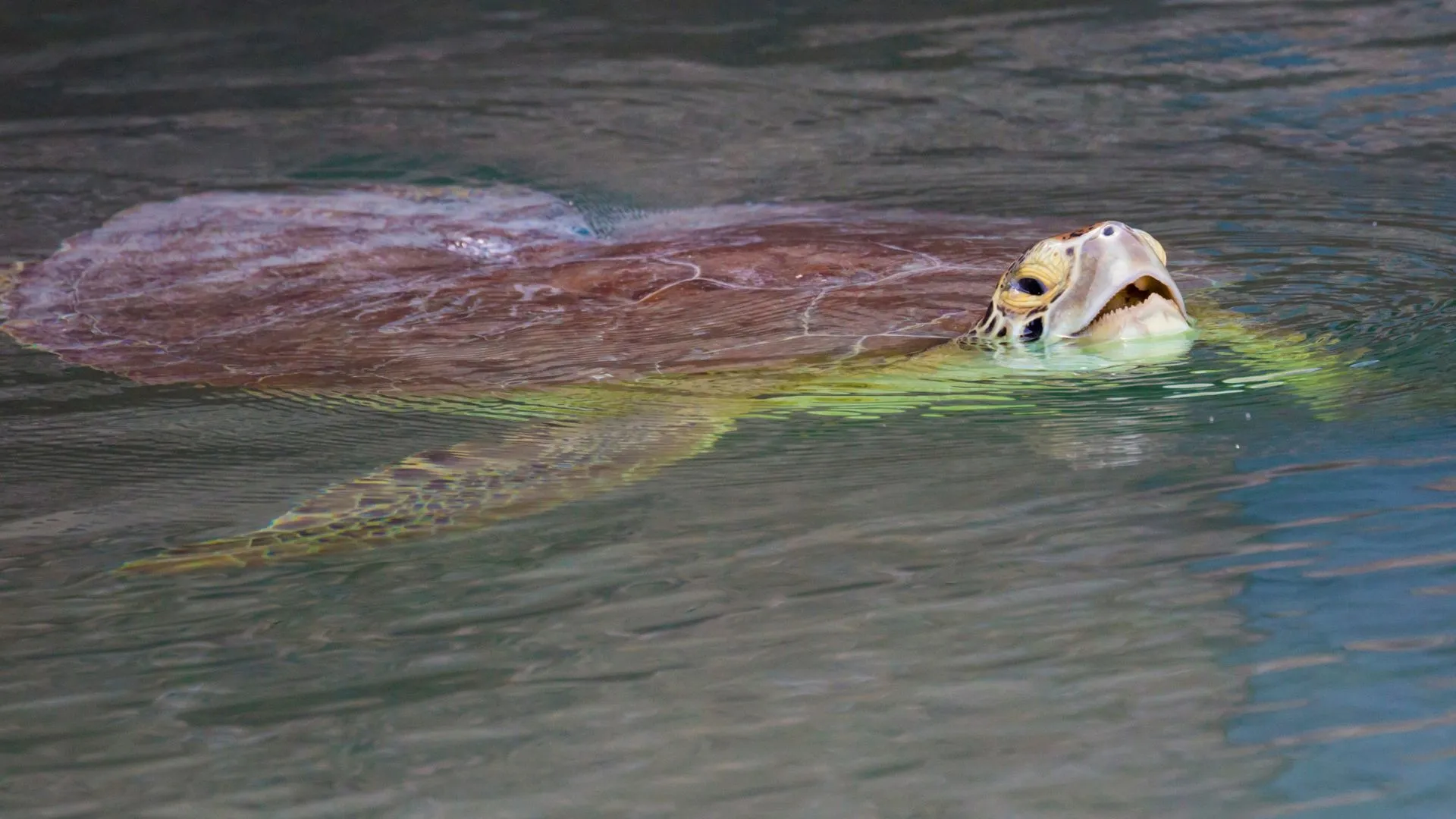
Fauna: Key Wildlife to Watch For
The convergence of different ecosystems makes Dry Tortugas National Park a hotspot for biodiversity.
Turtles
Given the park’s namesake, it’s no surprise that sea turtles frequent its waters. Loggerhead and green turtles are commonly sighted, especially during nesting seasons.
Hawksbill and leatherback turtles make rarer appearances.
Birds
From resident species to migratory visitors, the park is a birdwatcher’s paradise.
Notable species include the sooty tern, brown noddy, magnificent frigatebird, and the rare masked booby.
Fishes
The coral reefs and seagrass beds teem with fish of all shapes and sizes. Angelfish, parrotfish, grouper, and snapper are just a few of the myriad species that call the park’s waters home.

Conservation Efforts and How Visitors Can Help
Protecting this fragile environment is paramount. Over the years, various initiatives have been undertaken:
- Coral Restoration: Given the global decline of coral reefs, efforts are underway to restore and protect the park’s reefs. This includes transplanting resilient corals and monitoring reef health.
- Bird Nesting Protection: Areas like Bush Key are closed during nesting seasons to protect vulnerable bird populations.
- Marine Patrols: To prevent illegal fishing and ensure marine life remains undisturbed.
Visitors play a crucial role in conservation:
- Adhere to “Look but don’t touch” principles, especially when snorkeling or diving.
- Ensure no trash is left behind.
- Follow guidelines, especially in protected zones.
Dry Tortugas National Park is a living mosaic of ecosystems where every organism, big or small, plays a role.
It’s a reminder of the intricate balance of life and the responsibility we bear in preserving these natural wonders for future generations.
As you explore the park’s myriad offerings, take a moment to appreciate the symphony of life that unfolds around you.

Photography & Filming
In a world brimming with digital content, Dry Tortugas National Park stands out as a canvas that nature paints anew each day.
The blend of historical architecture, cerulean waters, and vibrant wildlife creates a paradise for shutterbugs.
Whether you’re an amateur enthusiast or a seasoned professional, the park offers a plethora of opportunities to capture stunning visuals.
Best Spots for Sunrise and Sunset
The isolation of Dry Tortugas means unobstructed horizons, making sunrises and sunsets a surreal experience.
Garden Key
With Fort Jefferson as a backdrop, sunrise at Garden Key is nothing short of magical. The early morning light bathes the fort’s walls, providing a unique, warm hue.
Loggerhead Key
The lighthouse here silhouetted against the setting sun offers a quintessential seascape shot, capturing the essence of Dry Tortugas.

Wildlife Photography Tips
Capturing the park’s diverse fauna requires a mix of patience and readiness.
- Birds in Flight: Use a fast shutter speed to freeze the motion of birds, especially during their dynamic take-offs and landings.
- Underwater Shots: A waterproof camera or housing is a must. When photographing the coral reefs, ensure you maintain buoyancy to avoid damaging the ecosystem.
- Golden Hours: Dawn and dusk offer softer light, which is ideal for capturing the textures and patterns of wildlife.
Drone Policies and Guidelines
Drones are becoming an essential tool for photographers, offering a bird’s-eye view of landscapes. However, there are specific guidelines in place:
- No-Drone Zones: Currently, drones are not permitted within Dry Tortugas National Park. This policy is in place to protect wildlife, especially nesting birds, and to maintain the tranquillity of the park.
- Stay Updated: Drone policies can evolve. Always check the latest regulations on the official National Park Service website before planning your trip.

Capturing Fort Jefferson
This architectural marvel provides numerous vantage points:
- Ramparts: Climb up to capture sweeping views of the surrounding waters.
- Interior Arches: The play of light and shadow within the fort’s archways creates a dramatic effect, especially during mid-mornings.
- Moat Reflections: On calm days, the moat around Fort Jefferson offers reflective shots, mirroring the fort’s grandeur.
Dry Tortugas National Park is more than just a destination; it’s a visual story waiting to be told.
While photographs and films can capture its beauty, they also bear the responsibility of promoting conscious tourism.
As you frame your shots, remember to respect the sanctity of nature and history, ensuring that the park’s tales continue to enchant for generations to come.
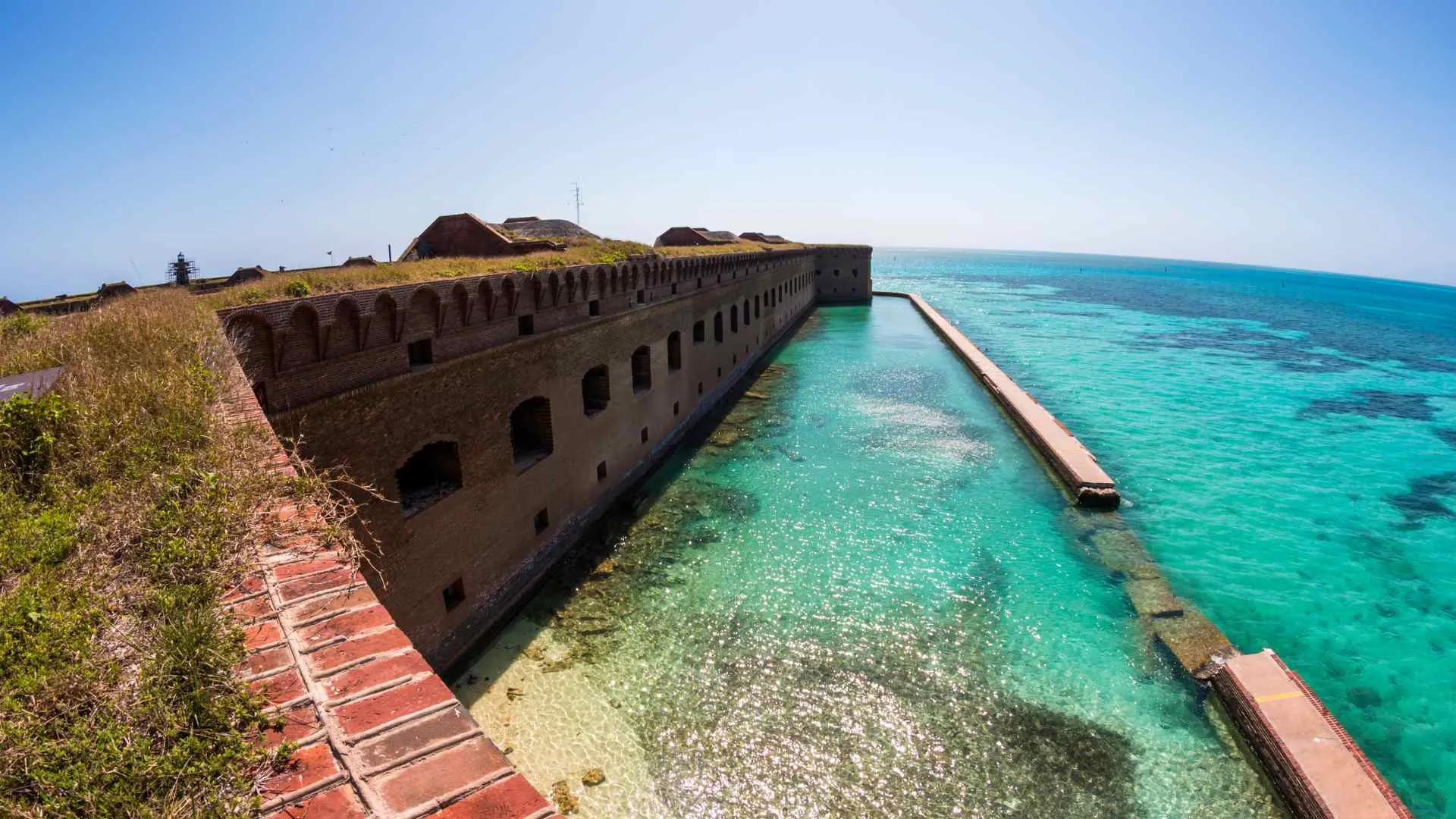
Safety & Regulations
Venturing into Dry Tortugas National Park is a journey into the wild embrace of nature, where the melding of sea and land offers both beauty and challenges.
While the park is a sanctuary of peace and natural splendor, visitors should be aware of specific safety measures and regulations designed to protect both the environment and its guests.
Park Rules and Regulations
Understanding and adhering to these guidelines ensures a harmonious experience for all visitors:
- Camping: Only permitted in designated areas. Ensure you have a reservation and always adhere to Leave No Trace principles.
- Fishing: While fishing is allowed, there are specific regulations regarding the type of fish, fishing methods, and designated fishing areas. Always consult with park rangers or the official park brochure.
- Wildlife Interactions: Feeding or harassing wildlife is strictly prohibited. This ensures their safety and that of visitors.
- Artifact Preservation: As a historical site, many artifacts can be found within the park, especially around Fort Jefferson. Removing or tampering with any historical items is illegal.
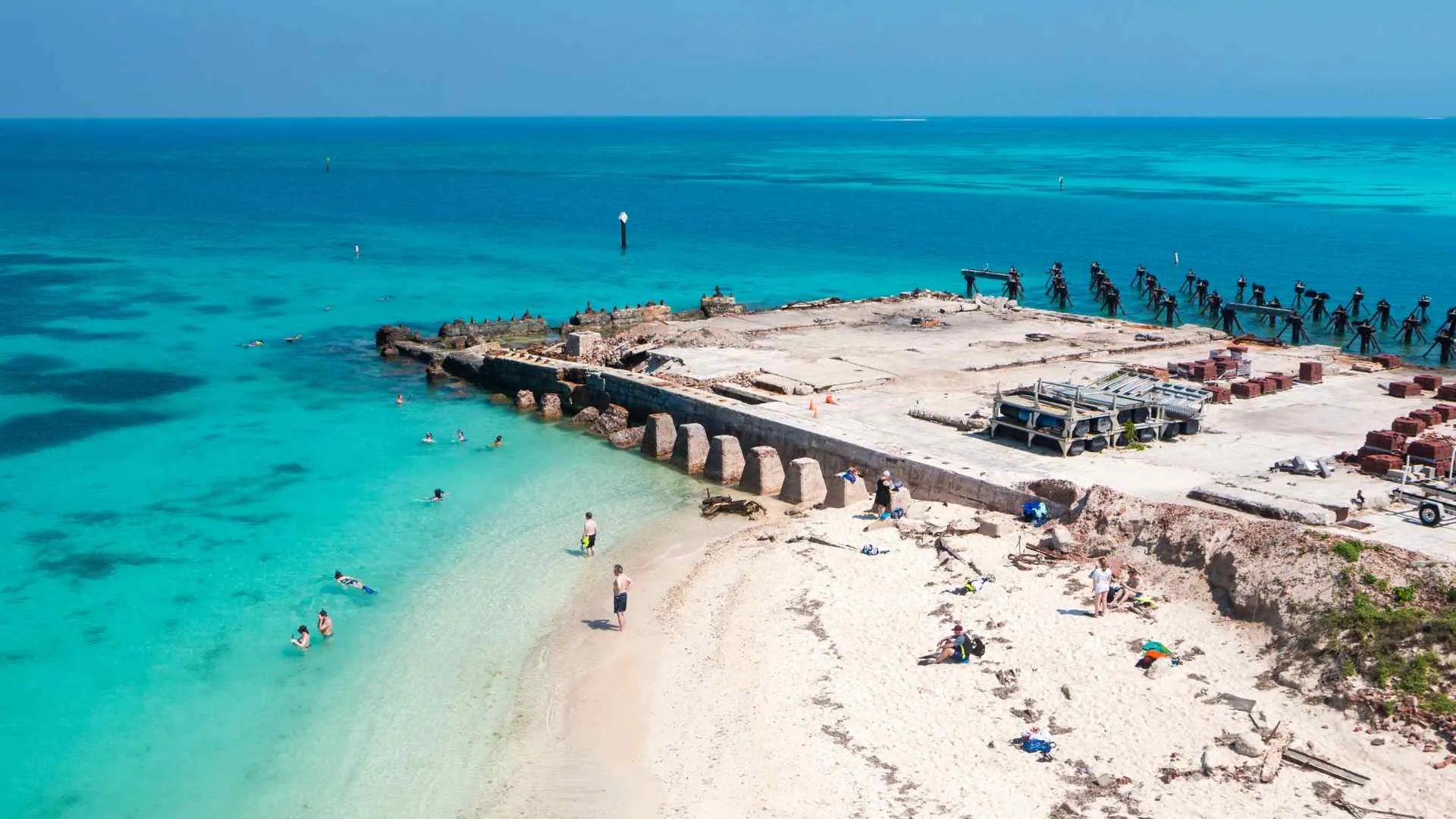
Weather-Related Safety
The park’s tropical climate presents its own set of challenges:
- Hurricanes: The park is susceptible to hurricanes, especially between June and November. Always check weather forecasts and advisories when planning your visit.
- Sun Exposure: The sun can be intense, especially during midday. Regularly apply sunscreen, wear protective clothing, and stay hydrated.
- Rain and Storms: Sudden rainstorms can occur. If you’re on a boat or planning to snorkel, be aware of changing weather conditions.
Wildlife Interaction Guidelines
- Birds: During nesting seasons, some areas might be off-limits to protect bird populations. Always observe birds from a distance and avoid causing any disturbances.
- Marine Life: While snorkeling or diving, avoid touching coral reefs or marine animals. Corals are delicate and can be damaged easily. Moreover, some marine creatures, like barracudas or jellyfish, can be dangerous if provoked.
- Insects: Mosquitoes and no-see-ums can be prevalent, especially during warmer months. Bring insect repellent and consider wearing long sleeves during dawn and dusk.

Staying Connected
Given its remote location, communication facilities are limited:
- Cell Reception: Mobile phone reception is sporadic at best. It’s recommended to inform someone of your travel plans before heading to the park.
- Emergency Contact: In case of emergencies, contact park rangers immediately. While the park staff is trained to handle various situations, evacuation or medical assistance might take time due to the park’s isolated location.
Exploring Dry Tortugas National Park is a venture into the heart of nature, where the echoes of history meld with the rhythms of the wild. While the allure of adventure beckons, safety should always be a priority.
By respecting the park’s regulations and being mindful of potential hazards, you ensure that your visit is not only memorable but also harmonious with the sanctuary that the Dry Tortugas represents.
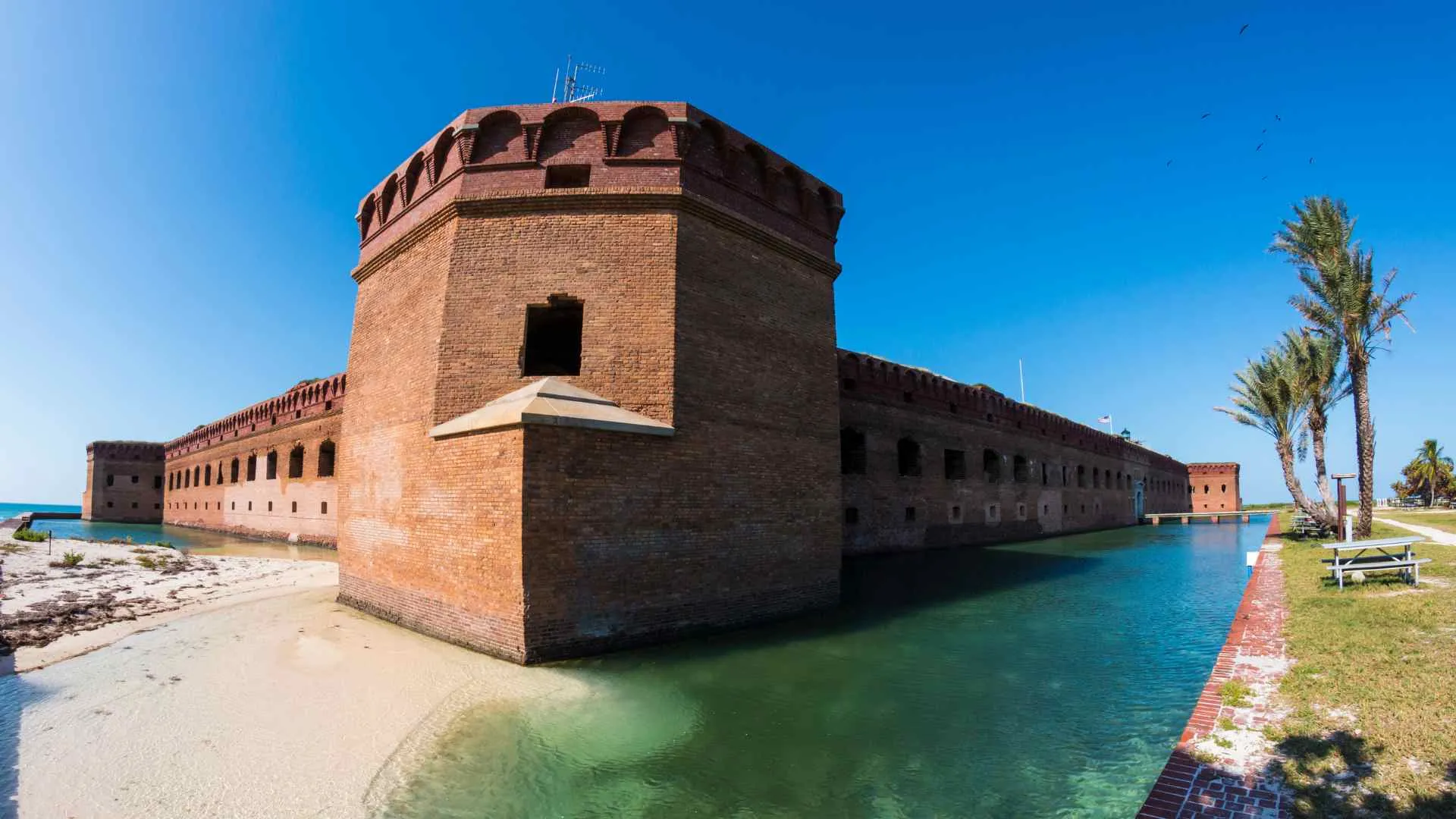
Sustainable Visitation
Dry Tortugas National Park offers a rare blend of pristine natural beauty and historical richness.
As visitors, we have the privilege to experience its wonders, but we also bear the responsibility of ensuring its preservation.
Sustainable visitation is all about minimizing our footprint and making choices that safeguard the park for future generations. Here’s how you can contribute:
Leave No Trace Principles
Rooted in respect for nature and other visitors, these guidelines are foundational for any national park visit:
- Plan Ahead and Prepare: Research the park’s specific guidelines and regulations to reduce potential harm.
- Travel and Camp on Durable Surfaces: Stick to marked trails and designated camping areas.
- Dispose of Waste Properly: Pack out all trash and litter. Leave places better than you found them.
- Leave What You Find: Do not pick plants, disturb wildlife, or remove artifacts. Let others experience the park’s wonders too.
- Minimize Campfire Impact: Use a camp stove for cooking instead of making a fire. If fires are permitted, use designated fire rings.
- Respect Wildlife: Observe from a distance. Do not feed or approach animals.
- Be Considerate of Other Visitors: Keep noise levels down and yield the trail when needed.

Minimizing Environmental Impact
Dry Tortugas National Park is especially sensitive given its unique ecosystems:
- Water Usage: Freshwater is limited. Use sparingly and consider bringing your own. Always avoid using soaps or detergents in natural water sources.
- Coral Care: When snorkeling or diving, avoid touching or standing on corals. They’re living organisms and can be damaged easily.
- Limit Plastic: Opt for reusable containers and cutlery. If you bring plastic items, ensure they’re securely stowed and disposed of responsibly.
Supporting Local Economies and Initiatives
Your visit can benefit the communities around the park:
- Shop Local: Purchase from local vendors and artisans in Key West or surrounding areas.
- Eco-Tours: Opt for tours that prioritize sustainability, education, and local engagement.
- Stay Informed: Participate in ranger-led programs to learn more about the park’s history, ecology, and conservation efforts.
Advocacy and Education
- Spread the Word: Share your sustainable visitation practices on social media or with fellow travelers, inspiring others to follow suit.
- Stay Educated: Continually educate yourself about best eco-practices and the evolving needs of the park.
Embracing sustainability during your visit to Dry Tortugas National Park ensures that its tales continue to inspire awe and wonder.
It’s a commitment to a legacy, a promise that the melodies of the ocean, the whispers of the fort’s walls, and the vibrant dance of its wildlife endure for all time.
Every small act counts, painting a brighter future for this unparalleled sanctuary.

Accommodations & Amenities
Dry Tortugas National Park offers a unique blend of isolation and untouched beauty.
While this means an unparalleled experience of nature, it also implies limited accommodations and amenities. Planning ahead is crucial to ensure a comfortable visit, and here’s what you can expect:
Nearby Lodging Options
While the park itself doesn’t have hotels or lodges, visitors have a few options:
Camping at Garden Key
For those seeking an authentic wilderness experience, the campground on Garden Key is the only on-site accommodation option.
- Facilities: The campground is primitive. There are picnic tables and grill areas, but no fresh water or food storage.
- Reservations: It operates on a first-come, first-served basis. However, due to its popularity, especially during peak seasons, it’s advisable to reserve your spot in advance.

Lodging in Key West
Many visitors opt to stay in Key West and make day trips to Dry Tortugas National Park.
- Options: Key West offers a variety of accommodations ranging from luxury resorts to quaint bed-and-breakfast establishments.
- Booking: Especially during peak season, ensure you book accommodations in advance.
Food and Drink Considerations
Given the park’s remote location, food and drink amenities are minimal:
- Bring Your Own: Visitors are advised to pack enough food and drink for their stay. Remember to bring fresh water, as there’s none available on the islands.
- Coolers: If you’re on a day trip, consider packing a cooler with fresh food and cold drinks. However, ensure it’s well-sealed to avoid attracting wildlife.
- Ferry Services: Some ferry services might offer basic snacks and drinks for purchase or as part of their package. It’s always good to check in advance.
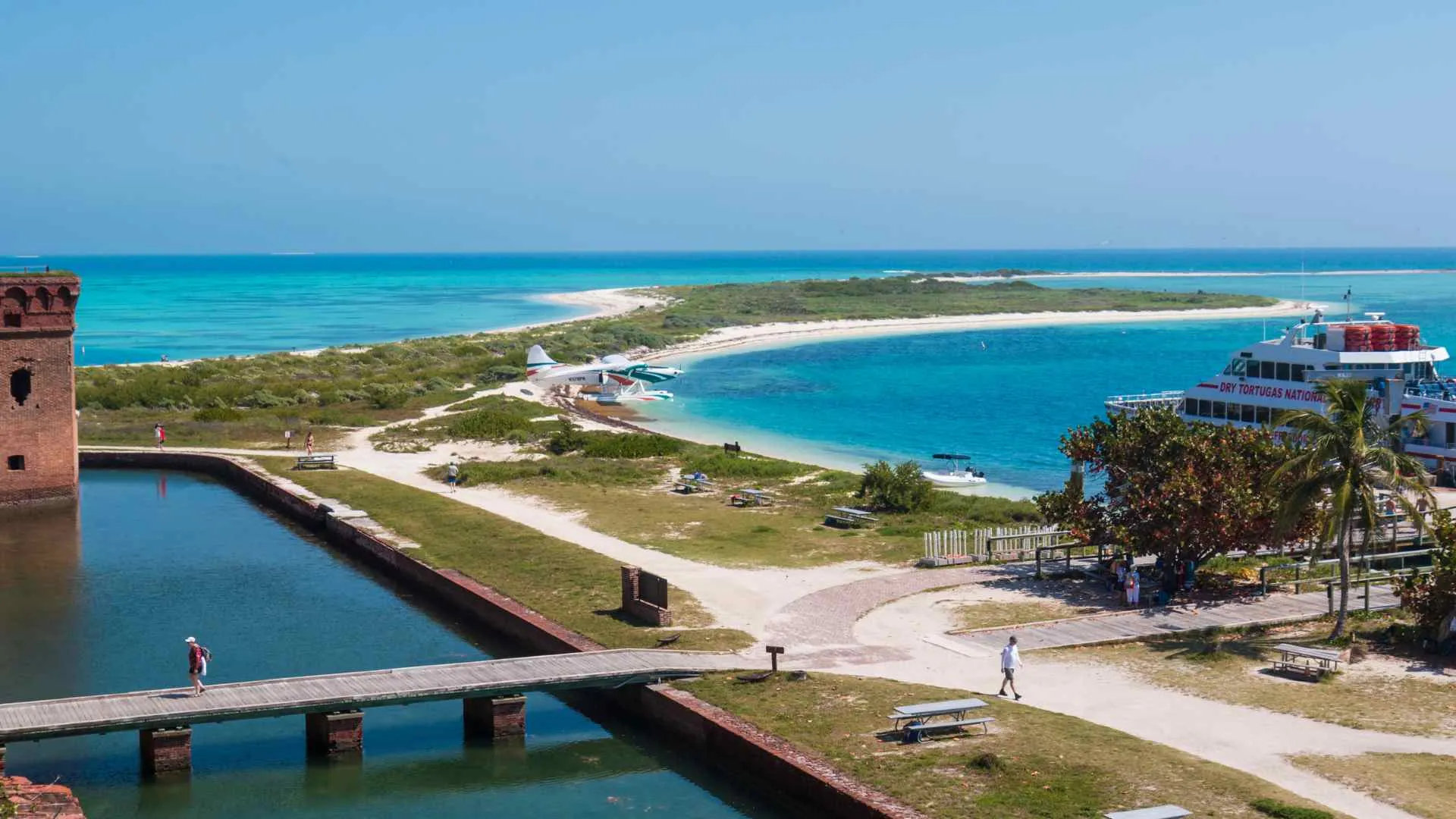
Restroom Facilities and Key Amenities
- Restrooms: Composting toilets are available on Garden Key near the campground and the visitor center. There are no shower facilities.
- Visitor Center: Located at Garden Key, the visitor center provides valuable information, maps, and sometimes ranger-led programs. It’s a great place to start your exploration.
- Bookstore: Operated by the non-profit Eastern National, the bookstore at Garden Key offers educational materials, souvenirs, and some basic supplies.
Visiting Dry Tortugas National Park is a journey back in time, where nature reigns supreme, and human footprint is minimal.
While this means sacrificing some modern comforts, the rewards — pristine beaches, vibrant marine life, and historical wonders — are well worth it.
Remember to plan, prepare, and pack wisely, ensuring a memorable and hassle-free experience in this unique slice of paradise.

Conclusion
Dry Tortugas National Park is more than a destination; it’s an enchanting realm where nature’s melodies and history’s whispers converge.
As the azure waters kiss sunlit shores and ancient walls recount tales of bygone eras, visitors are beckoned into a world that’s both timeless and ever-evolving.
The true essence of the park lies not just in its picturesque vistas but in the symbiotic dance of its ecosystems and the profound narratives it upholds.
As you depart from this hidden gem, cherish the memories, advocate for its preservation, and let its magic linger in your heart, calling you back, time and again.
FAQs on Dry Tortugas National Park
Navigating the intricacies of Dry Tortugas National Park can spark a myriad of questions.
To assist in your planning and ensure an enriching experience, here’s a compilation of frequently asked questions and their answers:
1. How do I get to Dry Tortugas National Park?
Answer: The park is accessible primarily by ferry or seaplane from Key West. Private boats are also allowed but must follow specific guidelines and obtain permits.
2. Can I bring my pet to the park?
Answer: Pets are allowed on the park’s main island, Garden Key, but must be on a leash at all times. They’re not allowed inside the fort or in the water.
3. Is there cell phone reception at the park?
Answer: Given its remote location, cell phone reception is sporadic and not reliable. It’s advisable to inform someone about your travel plans before heading to the park.
4. Can I scuba dive in the park?
Answer: Yes, scuba diving is permitted. While there are no dive shops or tank refill stations on the islands, several dive charters operate trips from Key West.
5. How long should I plan for my visit?
Answer: While day trips are popular, to truly experience the park’s essence, consider spending a night camping. This allows for stargazing, sunrise/sunset viewing, and ample time for snorkeling and exploring.
6. Are there any medical facilities on the islands?
Answer: No, the park does not have medical facilities. The nearest medical help is in Key West. Always carry a basic first-aid kit and be aware of your health and safety.
7. Can I fish in the park?
Answer: Yes, fishing is permitted, but specific regulations apply regarding the type of fish, fishing methods, and designated fishing areas. Always check the park’s official guidelines before fishing.
8. Are drones allowed in the park?
Answer: Currently, drones are prohibited within Dry Tortugas National Park to protect wildlife and maintain the tranquillity of the area.
9. Is there freshwater available on the islands?
Answer: No, there is no freshwater available on the islands. Visitors are advised to bring their own drinking water.
10. What’s the best time of year to visit?
Answer: While the park is open year-round, December to April is considered peak season due to pleasant weather. However, always check weather advisories, especially during hurricane season from June to November.
11. Are campfires allowed in the park?
Answer: No, campfires are not permitted anywhere within the park due to the sensitive environment. Campers can use small camp stoves for cooking.
12. Is snorkeling gear available for rent on the island?
Answer: The park itself doesn’t offer snorkeling gear rentals. However, some ferry services provide snorkeling equipment as part of their package. It’s advisable to check in advance or consider bringing your own.
13. Can I reserve a campsite online?
Answer: Camping spots on Garden Key operate on a first-come, first-served basis and currently cannot be reserved online. It’s best to arrive early, especially during peak season, to secure a spot.
14. Are there guided tours of Fort Jefferson?
Answer: Yes, ranger-led guided tours of Fort Jefferson are typically available and offer insights into the history and significance of the structure. Check the daily program schedule or inquire at the visitor center upon arrival.
15. Is swimming allowed around the islands?
Answer: Absolutely! Swimming is permitted, and the clear waters around the islands offer a refreshing dip. However, always be cautious of currents and marine life.
16. How do I obtain a private boating permit?
Answer: Visitors arriving by private boat must complete a permit (available at the park) and display it on their vessel. This permit is free and provides essential regulations and guidelines.
17. Are there any restrictions on collecting shells or other natural items?
Answer: Yes, collecting shells, coral, or any other natural or cultural items is strictly prohibited in the park. This ensures the preservation of the ecosystem and respects the park’s heritage.
18. Do I need to be aware of any marine animals while swimming or snorkeling?
Answer: While the waters are generally safe, it’s always good to be aware of your surroundings. Be cautious around sea urchins, jellyfish, and avoid touching any marine life. Larger animals like sharks are rare near swimming areas, but always exercise caution.
19. What should I do if the weather turns bad while I’m on the island?
Answer: In case of sudden weather changes, it’s advisable to seek shelter, preferably within Fort Jefferson, and stay informed through park rangers or announcements. Always check weather forecasts before heading to the park, especially during hurricane season.
20. Are there any special events or programs held in the park?
Answer: Dry Tortugas National Park occasionally hosts special events, workshops, and educational programs, especially during peak seasons. It’s best to check the official park website or inquire at the visitor center for any scheduled events during your visit.
